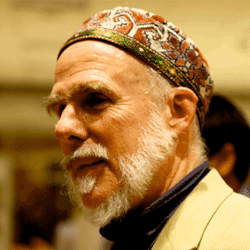What Role Does Culture Play in Islam?
Question: Could you please clarify what is the view of Islam regarding different peoples maintaining their native character and mentality, and being proud of them: I mean not in a bad way, which denies validity of other peoples, but simply appreciating what they have been given and cultivating it as their unique heritage? Does really Islam ultimately deny value of native, ancient heritage and cultivating it in terms of that which does not go against Islamic principles, like decent folk songs and costumes, symbols and distinctive, irreducible mentality and world-view? I ask this because I see that for many of my compatriots this is a major obstacle for accepting Islam: they might actually, perhaps partly unconsciously be considering Islam as something alien to our mentality, coming from distant Arab lands, suitable for Arabs; so they might see accepting Islam as a kind of treachery towards this ancient heritage, which additionally is already on the brink of extinction thanks to globalization, modernity and so on. However, I feel that it cannot be true – it is Allāh that created all the different peoples with their peculiarities as a sign from Him, not to be ignored and destroyed, and Islam is intended for all of those people.
I will truly appreciate any qualified suggestions and clarifications.
Answer: Assalaamu ‘alaykum wa rahmatullah. Please see below.
Maxim Five: Custom has the weight of law. (Taken from Dr. Umar Abd-Allah’s ‘Living Islam with Purpose.’)
This maxim is the theme of the Nawawi Foundation Paper “Islam and the Cultural Imperative,” which illustrates the importance of culture in Islam and the imperative that Muslims in America create their own distinctive indigenous culture.55 The maxim “culture has the weight of law” affirms that Islam is not culturally predatory, and it teaches Muslims to look upon all cultural heritages with an open mind, especially those where they live and to which they belong.
Once, a group of Ethiopian converts began to dance with drums and spears in the Prophet’s mosque in celebration of an annual Islamic festival. The Companion ‘Umar attempted to stop them, but the Prophet intervened and urged them to continue. In one Hadith, he said to them: “Play your games, sons of Ethiopia, so that the Jews and Christians know that there is flexibility (fusḥa) in our religion.”57 By this and similar acts, the Prophet set the precedent of affirming cultural differences and made it clear that, for non-Arabs, entering Islam did not require them to give up their own cultural norms for those of the Arabs.
The Qur’an revealed the following verse to the Prophet on the eve of his migration to Medina, where his legislative activity began.
It establishes several primary legal principles, acceptance of culture being one of them: “Accept from people what comes naturally for them; command what is good by custom; and turn away from the ignorant without responding in kind” (Qur’an 7:199). The Prophet’s attitude toward ethnic and cultural identity provides an example of the application of this verse. He did not destroy the indigenous cultures and subcultures of pre-Islamic Arabia, rather he lived in harmony with them, correcting what was unsound and repealing what was degenerate. Perhaps, the best example of the Prophet’s accommodation of Arabian subcultural norms was his practice of propagating the Qur’an in the seven principal dialectical variations (aḥruf) of Arabic. Throughout Arabia, the Arab tribes understood the Meccan dialect of the Prophet’s tribe, Quraysh, which served as the linguistic standard for all. The Prophet’s use of the seven dialectical variations was not a necessity; it was a respectful gesture toward the Arab tribes, which acknowledged the integrity of each tribe’s cultural identity.
The Prophet’s attitude toward the cultural norms of the Arab tribes and other ethnic groups constitutes a major precedent and a basic standard in Islamic law. Because the Prophet gave broad endorsement to diverse cultural conventions and did not alter them except when necessary, Abū Yūsuf, the principal student of Imam Abū Ḥanīfa, regarded Islam’s openness toward other cultures as the Prophet’s Sunna. Abū Yūsuf’s position contrasts sharply with certain Muslims today who regard the Sunna (narrowly defined as certain details of dress and personal behavior) as a substitute for culture.
Islamic legal theory regards sound cultural norms as constituting an independent and authoritative source of Islamic law. The noted Ḥanafī jurist al-Sarakhsī stated: “Whatever is established by good custom is equally well established by sound legal proof.”
Al-Tusūlī, a prominent Mālikī judge and legal scholar, wrote: “It is obligatory to let people follow their customs, usages, and general aspirations in life. To hand down rulings in opposition to them is gross deviation and tyranny.”
The word “custom” (ʿāda) as used in the maxim “custom has the weight of law” refers to acceptable cultural norms. Jurists define their usage of the word “custom” as “matters that are firmly established in practice and frequently repeated in people’s lives and acceptable to sound natures (al-ṭibāʿ al-salīma).” Reference to “sound natures” is linked to the Islamic belief that human beings are created with sound natures; humans are intrinsically good and endowed with basic intuitive knowledge of God, good and evil, benefit and harm. In a normative state, human beings adopt cultural norms suitable for themselves and the particular circumstances, times, and places in which they live. Thus, the basic purpose of cultural conventions is to obtain benefits and ward off harms to the furthest extent possible in widely divergent contexts. From the perspective of Islamic law, the nature of indigenous cultures and subcultures is fundamentally linked to the wellbeing of the social groups that have adopted them. For this reason, Muslim jurists regard Islam’s endorsement of diverse cultural norms as an instance of its overriding commitment to acquiring benefits and protecting from harms.
Cultural conventions make up a fundamental part of identity and have a strong hold over people accustomed to them. Islamic law acknowledges this reality and expresses it in the form of the legal maxim: “Custom is second nature” (al-ʿāda ṭabīʿa thāniya).
Customs are so deeply ingrained in people that it is difficult to distinguish them from their intrinsic natures. Therefore, it is all the more wise, from the standpoint of the law, to leave customs unchanged insofar as possible. Changing customary conventions unnecessarily is detrimental, because of the strong connection between customs and societal needs. When unhealthy customs must be altered or repealed, the process requires wise strategies and must be given time. Here again, the Prophet’s example sets the precedent; he brought his Companions into full compliance with Islamic norms gradually through a process that lasted more than two decades.
Some Muslims challenge the validity of indigenous customs by citing the Hadith mentioned earlier: “Whoever imitates (tashabbaha) a people belongs to them.” As noted, the Hadith condemns the servile imitation of others; it does not condemn healthy cultural interaction or the mere act of resembling (tashābaha) other people.
The value of such interaction is especially clear when it is done for laudable reasons like living with others harmoniously and building bridges of understanding and cooperation. Furthermore, it is indisputable in the light of a body of authentic Hadith that the Prophet himself often wore various types of non-Muslim clothing that were given to him as gifts from Byzantium, Yemen, and other distant regions.
When introduced to this maxim, “custom has the weight of law,” some American Muslims have anxieties about which indigenous customs are acceptable and which are not. In certain cases, their response reflects the culture of inhibition in which many of them grew up and the general presumption of prohibition common to that culture. It should also be noted that the word “culture” has taken on a pejorative meaning for many Muslims in America, especially those who come from immigrant families. For them, the word “culture” is often associated with the old world folkways of their parents, certain aspects of which they may deem to be “un-Islamic,” in conflict with American norms, or otherwise unacceptable.
“Custom has the weight of law” cannot be invoked to repeal what is clearly obligatory or prohibited in the Prophetic law, and the law categorically repudiates detrimental and degenerate customs.
But, as has been seen, Islamic law takes an open-minded attitude toward customs in general, and, when judging cultural norms, it prefers to err on the side of leniency and not rigidity. The presumption of permissibility also applies to indigenous customs; customs too must be presumed acceptable until proven otherwise. A relevant maxim states: “Permissibility is the basic rule in customs” (al-aṣl fi al-ʿādāt al-ibāḥa). As before, the burden of proof that a particular customary convention is impermissible falls exclusively on those who repudiate it, not on those who affirm it. Nevertheless, in borderline cases, the law prefers to err on the side of lenience. The applicable maxim in this regard states: “The basic rule in customs is exemption” (al-aṣl fī al-ʿādāt al-ʿafw), meaning that they are exempt from blame.
Accommodation of indigenous cultures made it possible for Islam to lay indigenous roots wherever it spread on the continents of Africa and Eurasia. Muslims learned new weights and measurements.
They adopted and enriched local languages. In addition to the Islamic lunar calendar, Muslims adopted solar and astral calendars to determine the seasons and the best times for planting and harvest. They designed distinctive styles of dress; the long onepiece garment (thawb) and many other items of clothing that some Muslims today call “Sunna” are largely cultural products and differ significantly from the dress of the Prophet and his Companions. Muslim cultural genius is still reflected in simple things like the ways they receive guests and prepare food and in grand things like their achievements in regional styles of art and architecture.
Throughout the pre-modern period, local expressions of Islam bore witness to indigenous cultural creativity. When Islam entered Indonesia, Muslims found that the standard Islamic call to prayer (adhān) did not always serve its purpose. The human voice could not carry well in the dense Indonesian rain forests. Muslims adopted the local cultural convention of communicating through “talking” drums. They preserved the Sunna of making the prayer call but complemented it by using enormous drums, which they hung horizontally outside their mosques and beat loudly to call people to prayer. The deep, hollow sounds of the drums resonated through the forests. The drumbeats signified that the place from which they came was empty and needed to be filled; they stopped what they were doing and came to prayer.
In many parts of Indonesia, Muslims worked in rice paddies and came to the mosques with muddy feet. Instead of repeatedly reminding the rice farmers to clean their feet before entering the mosques, indigenous architects constructed shallow pools in front of the mosque entrances. The farmers could not enter the mosques without walking through them, which cleaned their feet. But the standing water in the pools created the potential hazard of becoming habitats for mosquitoes and other insects. So the pools were also used tobreed carp; the fish ate the insect larvae, and the people ate the fish.
In speaking about creating an indigenous Muslim culture in the United States, it must be emphasized that such a culture would not be a single, monolithic whole, nor would it necessarily develop along the lines of the dominant culture or any particular subculture.
American culture, like human cultures everywhere, is not a single uniform entity. It is a complex of many diverse cultures and subcultures coexisting. They complement and compete against each other and have the same relation with the dominant culture of the mainstream. Endorsement of American culture means being open-minded toward all the multiple expressions of the indigenous cultural heritage. As emphasized before, the maxim “culture has the weight of law” disallows outright rejection of any of cultural or subcultural legacy; the maxim allows American Muslims to adopt or to adapt what they like from what they like as long as it is not detrimental. Our attitude should remain consistent with Islam’s default position that customs are presumed to be permissible, beneficial, and good until proven otherwise; in borderline cases, we have recourse to the maxim “the basic rule in customs is exemption.”
In traditional Muslim societies, creative adaptation of indigenous norms was conspicuous and often more beneficial than mere adoption of them. Likewise, American Muslims need not be content with just adopting good cultural norms; it is often better to adapt them imaginatively in order to produce results that are more beautiful and more beneficial than what existed before. In this regard, noteworthy achievements have already been made in areas like music, poetry, comedy, journalism, fiction, non-fiction, fashion, and interior design.
One of the most significant cultural challenges before American Muslims is to design truly indigenous styles of American mosques. The American mosque should not have a single set form. As stated above, American culture is multiplex; American mosques must reflect that complexity and suit the localities and neighborhoods where they are built. Several North American Muslim communities have made laudable efforts in this direction already.
Throughout history, Muslim mosques have been the products of regional cultures and subcultures. Islam does not dictate a set design for mosques; the only necessary architectural element in a mosque is that it have an area for prayer. Some Muslims regard domes and minarets as essential features of the mosque. The Prophet’s mosque did not have a dome or minarets during his lifetime.
Domes and minarets were post-Prophetic cultural innovations in the Muslim world. The dome were a relatively late development in Islamic architecture; its design was created to allow for expansive prayer areas that were not taken up by pillars in an age when builders did not have access to iron and steel beams. Minarets were also later developments. They were ideal for making the call to prayer in an age without microphones, but they also had a second primary purpose. Just as lighthouses are beacons for ships, minarets were originally beacons for caravans. Bonfires were lit on the tops of the minarets after the night prayer to give distant caravans a point of reference. The name “minaret” reflects their original cultural function; in Arabic mināra (minaret) means “place of fire.” Muslims in China, Andalusia, and North and West Africa did not adopt domes or minarets, in part, because they did not suit their environments.
A mosque should fit in harmoniously with its surroundings. Historically, the design, structure, and landscaping of mosques were suited to local and regional architectural norms, topography, and climate. Mosques should not clash with indigenous tastes and styles; they should not appear out of place or give the impression of being foreign transplants. Like all architectural achievements, creation of American mosque styles requires artistic, technical, and cultural genius. At a time when secular architecture is the dominant norm, the Western mosque must be attractive and inviting by today’s standards yet readily identifiable as sacred space.
Related Answers:
Giving & Receiving Christmas Gifts
Partaking in a Thanksgiving Dinner: Permitted or Not?
Did The Prophetﷺ or Companions Partake in Poetry?
Listening to Islamic Songs with Musical Instruments
Denim Clothes, Saris, and Imitating The Unbelievers
Can Women Wear Colourful Clothing?
Women & The Workplace
Related podcasts and videos:
In Conversation with Dr. Umar Abd-Allah: Islam and The Cultural Imperative
Mercy of Diversity: Cultivating Understanding Despite Difference (Shaykh Abdal Hakim Murad)


